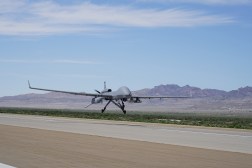The Defense Department is significantly overhauling its approach to airborne electronic warfare, investing upward of $7 billion in a new system to jam enemy surveillance systems and hide U.S. planes, ships and troops from enemy radars.
But the Government Accountability Office is concerned about the potential for redundant spending on duplicative services as DOD pays out that $7 billion — $3 billion for research and development and another $4 billion for procurement.
A report released Tuesday monitored the department’s planning for its next-generation jammer, or NGJ, from November 2012 to August 2013. While DOD has ensured NGJ will not overlap other military development efforts in its intended main role — suppressing enemy air defenses — the report found several military services — Air Force, Army, Marine Corps — are currently developing systems for purposes NGJ is expected to provide.
“DOD analyses of NGJ capabilities and potential duplication do not reflect all of its planned roles, particularly in irregular warfare environments, or evolving service acquisition plans,” the report reads.
The NGJ program was given the go-ahead on technology development in July 2013, but it has been in discussion for some time. For nearly a decade, DOD has been assessing gaps in its airborne electronic attack capabilities, currently powered by the ALQ-99, “a five-pod jamming system that is capable of automatically processing, and jamming radio frequency signals,” according to the report.
Basically, it keeps fighter jets and naval carriers from radar detection and missile targeting. On the ground, it also protects troops by interfering with enemy communications.
But enemy combatants have caught up with U.S. jamming technology, prompting the Navy to push for NGJ.
“NGJ is to primarily be based on aircraft carriers at sea where it is to be employed in U.S. Navy carrier strike groups to counter both sea- and land-based weapon systems,” the report reads. “It is also expected to be capable of conducting stand-off jamming missions, in which the aircraft is located outside of defended airspace. In both cases, the idea is to protect or ‘hide’ other systems from enemy radars.”
 How the new airborne electronic attack systems will counter enemy air defenses (Image: GAO presentation)
How the new airborne electronic attack systems will counter enemy air defenses (Image: GAO presentation)In these primary roles, the report found, NGJ is not overlapping with other development efforts.
“However, these analyses do not address potential duplication or overlap between the NGJ and other systems being developed for other roles, such as communications jamming in irregular warfare environments,” the report reads.
Air Force officials told GAO that NGJ will “complement” systems it is developing to improve the electronic attack capabilities of several of its F-series fighter jets. The Army said it has already started developing its own jamming pod that is less expensive and less powerful, because it “plans to rely on its own airborne electronic attack systems to perform the necessary jamming in support of its ground systems.”
The Marine Corps will stop acquiring the EA-18G — the plane equipped with NGJ — by 2019, so it is continuing to develop its own airborne attack capabilities for each of its Marine Air Ground Task Force commanders.
The report recommends Defense Secretary Chuck Hagel collaborate with the Navy and Joint Staff to discuss these areas of potential overlap and include their findings in the NGJ’s capability development documents. It also suggests that going forward, the Electronic Warfare Strategy Report to Congress — which already occurs — include information on these “potentially overlapping capabilities among systems.”
After reading a draft of the report, DOD agreed with the second recommendation, but not completely with the first.
“DOD agreed to continue to assess duplication and redundancies but not with using the capability development document to do so,” the report reads. “GAO believes the recommendation remains valid.”







